人教八年级英语下册第五单元复习课件(32张)
文档属性
| 名称 | 人教八年级英语下册第五单元复习课件(32张) | 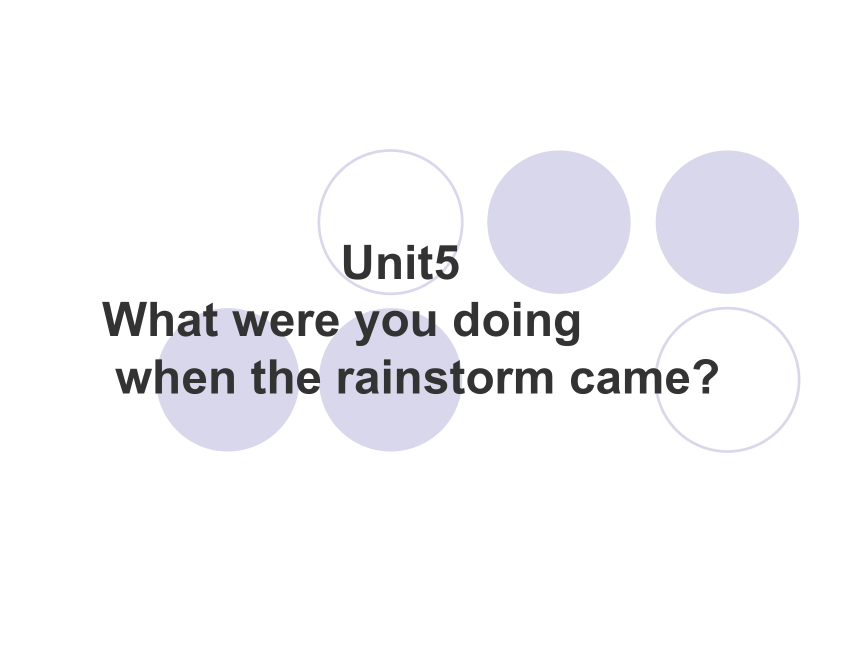 | |
| 格式 | zip | ||
| 文件大小 | 637.0KB | ||
| 资源类型 | 教案 | ||
| 版本资源 | 人教新目标(Go for it)版 | ||
| 科目 | 英语 | ||
| 更新时间 | 2020-05-01 08:42:11 | ||
图片预览

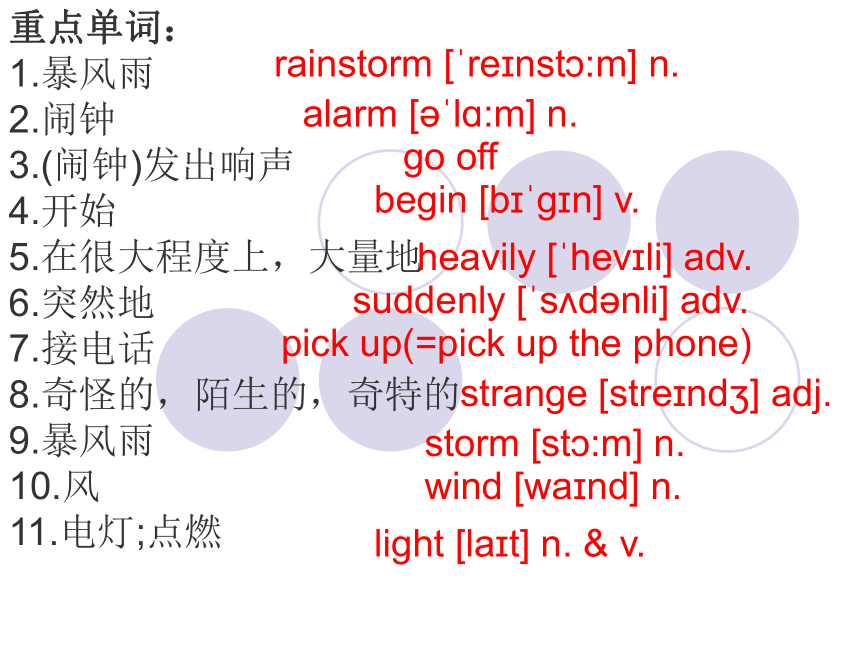

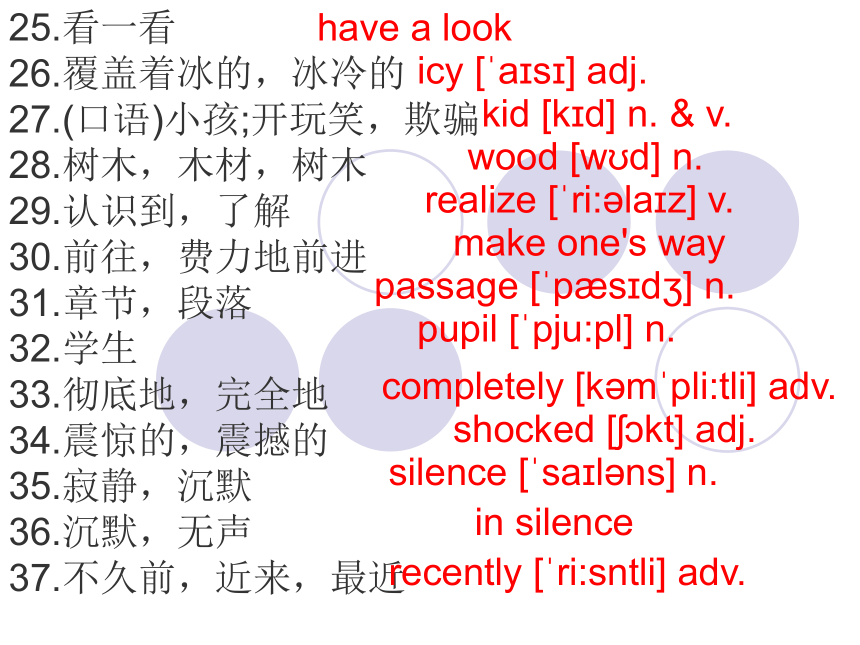


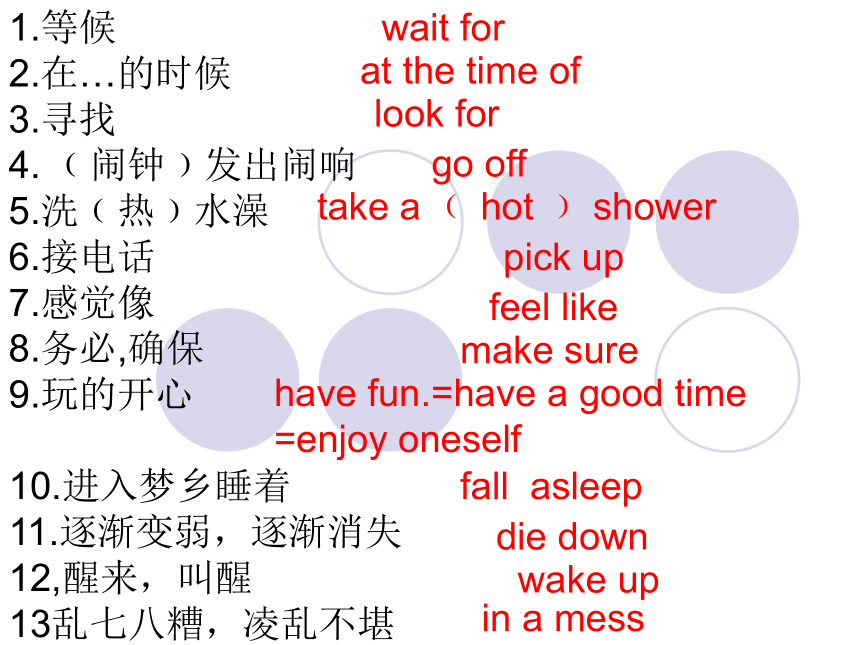
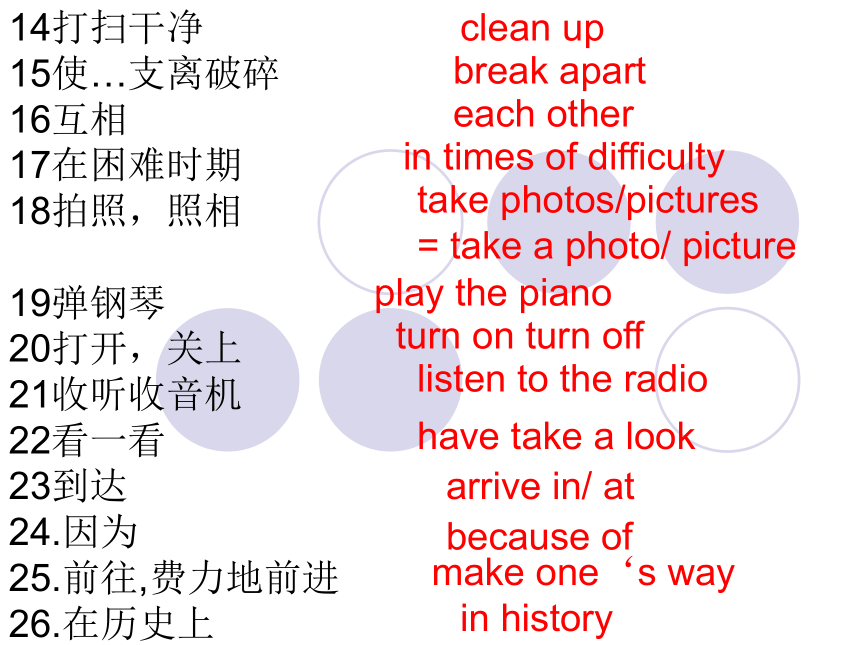
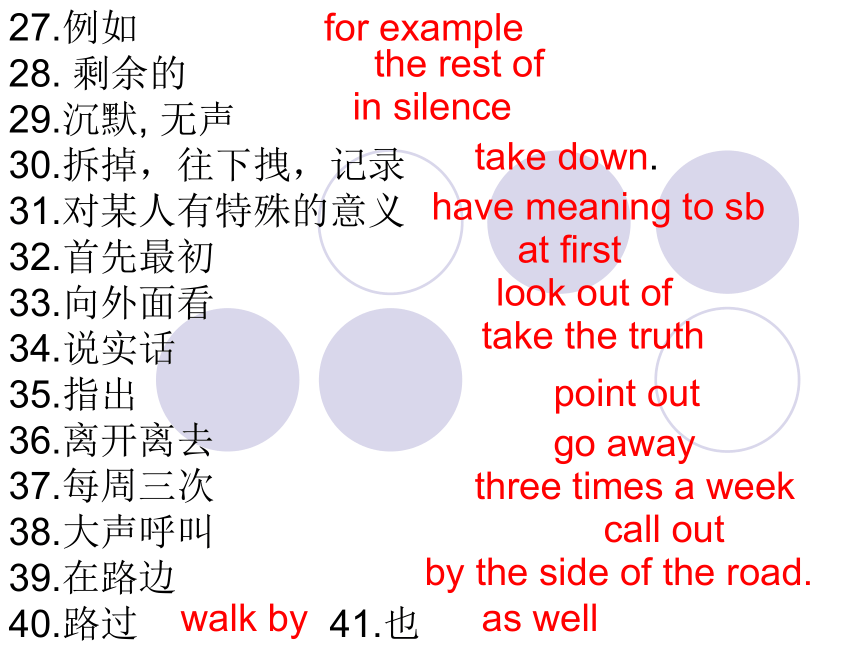

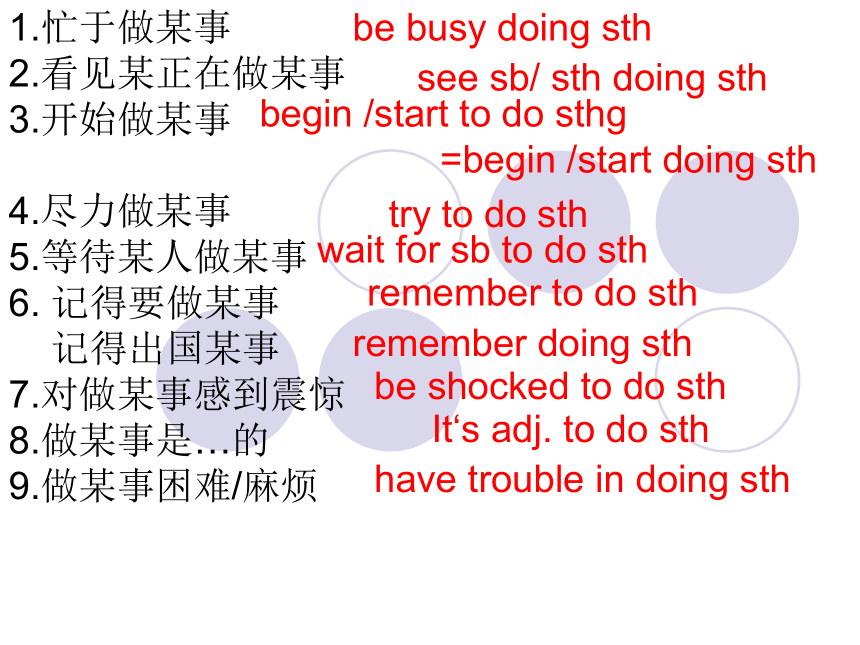
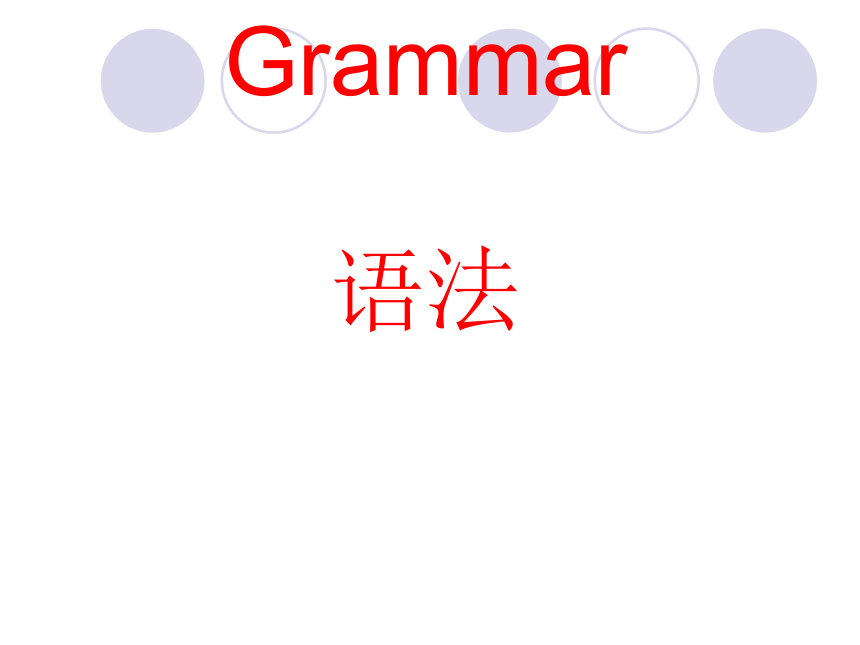
文档简介
(共33张PPT)
大图模式
Unit5
What were you doing
when the rainstorm came?
重点单词:
1.暴风雨
2.闹钟
3.(闹钟)发出响声
4.开始
5.在很大程度上,大量地
6.突然地
7.接电话
8.奇怪的,陌生的,奇特的
9.暴风雨
10.风
11.电灯;点燃
rainstorm [?re?nst?:m] n.
alarm [??lɑ:m] n.
go off
begin [b??g?n] v.
heavily [?hev?li] adv.
suddenly [?s?d?nli] adv.
pick up(=pick up the phone)
strange [stre?nd?] adj.
storm [st?:m] n.
wind [wa?nd] n.
light [la?t] n. & v.
12.报导,报告
13.范围,地域,地区
14.窗户
15.手电筒,火炬
16.火柴,比赛
17.敲打,打败
18.反对,对…不利
19.睡着的,熟睡的
20.进入梦乡,睡着
21.逐渐变弱,逐渐消失
22.上升,升起
23.倒下的,落下的
24.分离,分开
report [ri?p?:t] v.
area ['e?r??] n.
window [?wind?u] n.
flashlight ['fl??la?t] n.
match [m?t?] n.
beat [bi:t] v.
against [??genst] prep.
asleep [??sli:p] adj.
fall asleep
die down
rise [ra?z] v.
fallen [?f?:l?n] adj.
apart [??pɑ:t] adv.
25.看一看
26.覆盖着冰的,冰冷的
27.(口语)小孩;开玩笑,欺骗
28.树木,木材,树木
29.认识到,了解
30.前往,费力地前进
31.章节,段落
32.学生
33.彻底地,完全地
34.震惊的,震撼的
35.寂静,沉默
36.沉默,无声
37.不久前,近来,最近
have a look
icy [?a?s?] adj.
kid [k?d] n. & v.
wood [w?d] n.
realize [?ri:?la?z] v.
make one's way
passage [?p?s?d?] n.
pupil [?pju:pl] n.
completely [k?m?pli:tli] adv.
shocked [??kt] adj.
silence [?sa?l?ns] n.
in silence
recently [?ri:sntli] adv.
38.拆除,往下拽,记录
39.恐怖分子
40.日期,日子
41.塔
42.首先,最初
43.真相,真理,事实
take down
terrorist [?ter?r?st] n.
date [de?t] n.
tower [?ta??(r)] n.
at first
truth [tru:θ] n.
重 点 短 语
1.等候
2.在…的时候
3.寻找
4. ﹙闹钟﹚发出闹响
5.洗﹙热﹚水澡
6.接电话
7.感觉像
8.务必,确保
9.玩的开心
10.进入梦乡睡着
11.逐渐变弱,逐渐消失
12,醒来,叫醒
13乱七八糟,凌乱不堪
wait for
at the time of
look for
go off
take a ﹙ hot ﹚ shower
pick up
feel like
make sure
have fun.=have a good time
=enjoy oneself
fall asleep
die down
wake up
in a mess
14打扫干净
15使…支离破碎
16互相
17在困难时期
18拍照,照相
19弹钢琴
20打开,关上
21收听收音机
22看一看
23到达
24.因为
25.前往,费力地前进
26.在历史上
clean up
break apart
each other
in times of difficulty
take photos/pictures
= take a photo/ picture
play the piano
turn on turn off
listen to the radio
have take a look
arrive in/ at
because of
make one‘s way
in history
27.例如
28. 剩余的
29.沉默, 无声
30.拆掉,往下拽,记录
31.对某人有特殊的意义
32.首先最初
33.向外面看
34.说实话
35.指出
36.离开离去
37.每周三次
38.大声呼叫
39.在路边
40.路过 41.也
for example
the rest of
in silence
take down.
have meaning to sb
at first
look out of
take the truth
point out
go away
three times a week
call out
by the side of the road.
walk by
as well
用 法 集 萃
1.忙于做某事
2.看见某正在做某事
3.开始做某事
4.尽力做某事
5.等待某人做某事
6. 记得要做某事
记得出国某事
7.对做某事感到震惊
8.做某事是…的
9.做某事困难/麻烦
be busy doing sth
see sb/ sth doing sth
begin /start to do sthg
=begin /start doing sth
try to do sth
wait for sb to do sth
remember to do sth
remember doing sth
be shocked to do sth
It‘s adj. to do sth
have trouble in doing sth
Grammar
语法
一、定义:
在英语中不同时间发生的动作/或存在的状态要用不同的动词形式来表示,这每一种不同的形式就叫做时态。
谓语动词
用法:①此刻动作:表示目前正在发生的动作。②现阶段动作:表示目前一个时期一直在进行的动作,此刻不一定在进行。
构成:am/is/are+动词的现在分词
标志词:now, at present, at the moment, these days, look, listen
例句:Look! What are the children doing over there?看,孩子们在那边做什么呢?
现在进行时
表示位置移动或状态转移的动词(come ,go, leave, arrive)等少数动词的现在进行时形式可表示将要发生的动作。
注意
过去进行时定义
过去进行时表示过去某一时刻或某一段时间内正在进行或发生的动作。
过去进行时的结构
否定形式
问句形式
was/were + not + doing
Was/Were+主语+doing?
He was sleeping at that time.
He wasn’t sleeping at that time.
Was he sleeping at that time?
that moment,,when/while表示过去时间的状语从句
then, at that time, this time yesterday, at 5 o’clock last night, all night, all the morning, from 7:00 to 9:00 yesterday…
They were having a class this time yesterday.
I was drawing a horse when the teacher came in.
过去进行时标志词
动现在分词变化规则
口诀 规则 例子
直 1. 一般情况下,直接在动词后加-ing。 play –playing
去 2. 动词以不发音的-e结尾,要去-e加-ing。 take – taking
双 3.重读闭音节的动词,要双写词尾字母,再加-ing。 cut – cutting
变 4. 以-ie结尾的动词,把ie变成y再加-ing。 lie - lying
易错点1
when的用法
when和while引导时间状语从句
1. 状语从句表示短时间的动作,主句常用进行时态或完成时态。
When I came in, he was reading the newspaper.
非延续性动词:come, go, leave, arrive, meet, die等。
易错点1
when的用法
when和while引导时间状语从句
2. 状语从句表示长时间的动作或状态,主句常用进行时态。
When she was making a call, I was writing a letter.
易错点1
when的用法
when和while引导时间状语从句
3. 表示突然发生某事,意思是“正在……时突然”,主句常用过去进行时,when从句常用一般过去时。
I was just coming along to see you when I ran into Wilson.
易错点1
while的用法
when和while引导时间状语从句
1. 主句和从句都用一般过去时。
She listened carefully while he read.
延续性动词:read, study, sleep, write, listen, watch等。
易错点1
while的用法
when和while引导时间状语从句
2. 从句用过去进行时,主句用一般过去时。
While I was watching TV, Tom came in.
易错点1
while的用法
when和while引导时间状语从句
3. 主句和从句都用过去进行时。
While I was watching TV, she was doing some cleaning.
易错点2
用法不同
过去进行时和一般过去时的区别
过去进行时 一般过去时
1. 表示动作在持续或未完成。 1. 表示某一动作已经完成。
2. 表示动作反复地进行。 2. 表示只做一次动作。
易错点2
用法不同
过去进行时和一般过去时的区别
She was writing a letter to her friend at eight last night.
She wrote a letter to her friend last night.
(信不一定写完)
(信写完了)
She waved to me.
She was waving to me.
(挥了挥手)
(反复挥手)
易错点2
标志词不同
过去进行时和一般过去时的区别
过去进行时 一般过去时
过去时间点:at that time, this time yesterday, at 7 o’clock yesterday evening等。 过去时间点:just now, yesterday, this morning, three years ago等。
过去时间段:from six to nine yesterday, from morning till night, all those days等。 过去时间段:in the past, in + 过去的年份, last week, once upon a time等。
易错点2
过去进行时和一般过去时的区别
We were having supper at this time yesterday.
It was raining all those days.
I was reading English while my mother was cooking breakfast.
(过去进行时)
易错点2
过去进行时和一般过去时的区别
I lived in Beijing three years ago.
The first Olympic Games happened in 1896.
Anny used to be short, but she becomes taller now.
(一般过去时)
【典例1】Little Tom ______ computer games when his mother got home.
A. is playing B. plays
C. was playing D. playing
考查时态。句意:当妈妈到家的时候,小汤姆正在玩电脑游戏。when引导时间状语从句,主句多用进行时,时间发生在过去,故用过去进行时。
【典例2】 Turn off the water while you ______ your teeth or washing your hands.
A. were brushing B. brush
C. are brushing D. brushed
考查时态。句意:当你刷牙或洗手的时候,请关掉水龙头。while引导时间状语从句,时态保持一致,brushing与washing并列;习惯的动作,故选现在进行时。
【典例3】—I called you at 8:00 yesterday evening, but no one answered.
—Sorry, I ______ clothes at that time.
A. wash B. washed
D. am washing D. was washing
考查时态。句意:—昨晚八点我打电话给你,但是没有人接。—不好意思,那个时候我正在洗衣服。at that time为过去进行时标志词,选用was/were doing。
大图模式
Unit5
What were you doing
when the rainstorm came?
重点单词:
1.暴风雨
2.闹钟
3.(闹钟)发出响声
4.开始
5.在很大程度上,大量地
6.突然地
7.接电话
8.奇怪的,陌生的,奇特的
9.暴风雨
10.风
11.电灯;点燃
rainstorm [?re?nst?:m] n.
alarm [??lɑ:m] n.
go off
begin [b??g?n] v.
heavily [?hev?li] adv.
suddenly [?s?d?nli] adv.
pick up(=pick up the phone)
strange [stre?nd?] adj.
storm [st?:m] n.
wind [wa?nd] n.
light [la?t] n. & v.
12.报导,报告
13.范围,地域,地区
14.窗户
15.手电筒,火炬
16.火柴,比赛
17.敲打,打败
18.反对,对…不利
19.睡着的,熟睡的
20.进入梦乡,睡着
21.逐渐变弱,逐渐消失
22.上升,升起
23.倒下的,落下的
24.分离,分开
report [ri?p?:t] v.
area ['e?r??] n.
window [?wind?u] n.
flashlight ['fl??la?t] n.
match [m?t?] n.
beat [bi:t] v.
against [??genst] prep.
asleep [??sli:p] adj.
fall asleep
die down
rise [ra?z] v.
fallen [?f?:l?n] adj.
apart [??pɑ:t] adv.
25.看一看
26.覆盖着冰的,冰冷的
27.(口语)小孩;开玩笑,欺骗
28.树木,木材,树木
29.认识到,了解
30.前往,费力地前进
31.章节,段落
32.学生
33.彻底地,完全地
34.震惊的,震撼的
35.寂静,沉默
36.沉默,无声
37.不久前,近来,最近
have a look
icy [?a?s?] adj.
kid [k?d] n. & v.
wood [w?d] n.
realize [?ri:?la?z] v.
make one's way
passage [?p?s?d?] n.
pupil [?pju:pl] n.
completely [k?m?pli:tli] adv.
shocked [??kt] adj.
silence [?sa?l?ns] n.
in silence
recently [?ri:sntli] adv.
38.拆除,往下拽,记录
39.恐怖分子
40.日期,日子
41.塔
42.首先,最初
43.真相,真理,事实
take down
terrorist [?ter?r?st] n.
date [de?t] n.
tower [?ta??(r)] n.
at first
truth [tru:θ] n.
重 点 短 语
1.等候
2.在…的时候
3.寻找
4. ﹙闹钟﹚发出闹响
5.洗﹙热﹚水澡
6.接电话
7.感觉像
8.务必,确保
9.玩的开心
10.进入梦乡睡着
11.逐渐变弱,逐渐消失
12,醒来,叫醒
13乱七八糟,凌乱不堪
wait for
at the time of
look for
go off
take a ﹙ hot ﹚ shower
pick up
feel like
make sure
have fun.=have a good time
=enjoy oneself
fall asleep
die down
wake up
in a mess
14打扫干净
15使…支离破碎
16互相
17在困难时期
18拍照,照相
19弹钢琴
20打开,关上
21收听收音机
22看一看
23到达
24.因为
25.前往,费力地前进
26.在历史上
clean up
break apart
each other
in times of difficulty
take photos/pictures
= take a photo/ picture
play the piano
turn on turn off
listen to the radio
have take a look
arrive in/ at
because of
make one‘s way
in history
27.例如
28. 剩余的
29.沉默, 无声
30.拆掉,往下拽,记录
31.对某人有特殊的意义
32.首先最初
33.向外面看
34.说实话
35.指出
36.离开离去
37.每周三次
38.大声呼叫
39.在路边
40.路过 41.也
for example
the rest of
in silence
take down.
have meaning to sb
at first
look out of
take the truth
point out
go away
three times a week
call out
by the side of the road.
walk by
as well
用 法 集 萃
1.忙于做某事
2.看见某正在做某事
3.开始做某事
4.尽力做某事
5.等待某人做某事
6. 记得要做某事
记得出国某事
7.对做某事感到震惊
8.做某事是…的
9.做某事困难/麻烦
be busy doing sth
see sb/ sth doing sth
begin /start to do sthg
=begin /start doing sth
try to do sth
wait for sb to do sth
remember to do sth
remember doing sth
be shocked to do sth
It‘s adj. to do sth
have trouble in doing sth
Grammar
语法
一、定义:
在英语中不同时间发生的动作/或存在的状态要用不同的动词形式来表示,这每一种不同的形式就叫做时态。
谓语动词
用法:①此刻动作:表示目前正在发生的动作。②现阶段动作:表示目前一个时期一直在进行的动作,此刻不一定在进行。
构成:am/is/are+动词的现在分词
标志词:now, at present, at the moment, these days, look, listen
例句:Look! What are the children doing over there?看,孩子们在那边做什么呢?
现在进行时
表示位置移动或状态转移的动词(come ,go, leave, arrive)等少数动词的现在进行时形式可表示将要发生的动作。
注意
过去进行时定义
过去进行时表示过去某一时刻或某一段时间内正在进行或发生的动作。
过去进行时的结构
否定形式
问句形式
was/were + not + doing
Was/Were+主语+doing?
He was sleeping at that time.
He wasn’t sleeping at that time.
Was he sleeping at that time?
that moment,,when/while表示过去时间的状语从句
then, at that time, this time yesterday, at 5 o’clock last night, all night, all the morning, from 7:00 to 9:00 yesterday…
They were having a class this time yesterday.
I was drawing a horse when the teacher came in.
过去进行时标志词
动现在分词变化规则
口诀 规则 例子
直 1. 一般情况下,直接在动词后加-ing。 play –playing
去 2. 动词以不发音的-e结尾,要去-e加-ing。 take – taking
双 3.重读闭音节的动词,要双写词尾字母,再加-ing。 cut – cutting
变 4. 以-ie结尾的动词,把ie变成y再加-ing。 lie - lying
易错点1
when的用法
when和while引导时间状语从句
1. 状语从句表示短时间的动作,主句常用进行时态或完成时态。
When I came in, he was reading the newspaper.
非延续性动词:come, go, leave, arrive, meet, die等。
易错点1
when的用法
when和while引导时间状语从句
2. 状语从句表示长时间的动作或状态,主句常用进行时态。
When she was making a call, I was writing a letter.
易错点1
when的用法
when和while引导时间状语从句
3. 表示突然发生某事,意思是“正在……时突然”,主句常用过去进行时,when从句常用一般过去时。
I was just coming along to see you when I ran into Wilson.
易错点1
while的用法
when和while引导时间状语从句
1. 主句和从句都用一般过去时。
She listened carefully while he read.
延续性动词:read, study, sleep, write, listen, watch等。
易错点1
while的用法
when和while引导时间状语从句
2. 从句用过去进行时,主句用一般过去时。
While I was watching TV, Tom came in.
易错点1
while的用法
when和while引导时间状语从句
3. 主句和从句都用过去进行时。
While I was watching TV, she was doing some cleaning.
易错点2
用法不同
过去进行时和一般过去时的区别
过去进行时 一般过去时
1. 表示动作在持续或未完成。 1. 表示某一动作已经完成。
2. 表示动作反复地进行。 2. 表示只做一次动作。
易错点2
用法不同
过去进行时和一般过去时的区别
She was writing a letter to her friend at eight last night.
She wrote a letter to her friend last night.
(信不一定写完)
(信写完了)
She waved to me.
She was waving to me.
(挥了挥手)
(反复挥手)
易错点2
标志词不同
过去进行时和一般过去时的区别
过去进行时 一般过去时
过去时间点:at that time, this time yesterday, at 7 o’clock yesterday evening等。 过去时间点:just now, yesterday, this morning, three years ago等。
过去时间段:from six to nine yesterday, from morning till night, all those days等。 过去时间段:in the past, in + 过去的年份, last week, once upon a time等。
易错点2
过去进行时和一般过去时的区别
We were having supper at this time yesterday.
It was raining all those days.
I was reading English while my mother was cooking breakfast.
(过去进行时)
易错点2
过去进行时和一般过去时的区别
I lived in Beijing three years ago.
The first Olympic Games happened in 1896.
Anny used to be short, but she becomes taller now.
(一般过去时)
【典例1】Little Tom ______ computer games when his mother got home.
A. is playing B. plays
C. was playing D. playing
考查时态。句意:当妈妈到家的时候,小汤姆正在玩电脑游戏。when引导时间状语从句,主句多用进行时,时间发生在过去,故用过去进行时。
【典例2】 Turn off the water while you ______ your teeth or washing your hands.
A. were brushing B. brush
C. are brushing D. brushed
考查时态。句意:当你刷牙或洗手的时候,请关掉水龙头。while引导时间状语从句,时态保持一致,brushing与washing并列;习惯的动作,故选现在进行时。
【典例3】—I called you at 8:00 yesterday evening, but no one answered.
—Sorry, I ______ clothes at that time.
A. wash B. washed
D. am washing D. was washing
考查时态。句意:—昨晚八点我打电话给你,但是没有人接。—不好意思,那个时候我正在洗衣服。at that time为过去进行时标志词,选用was/were doing。
同课章节目录
- Unit 1 What's the matter?
- Section A
- Section B
- Unit 2 I'll help to clean up the city parks.
- Section A
- Section B
- Unit 3 Could you please clean your room?
- Section A
- Section B
- Unit 4 Why don't you talk to your parents?
- Section A
- Section B
- Unit 5 What were you doing when the rainstorm came
- Section A
- Section B
- Review of Units 1-5
- Unit 6 An old man tried to move the mountains.
- Section A
- Section B
- Unit 7 What's the highest mountain in the world?
- Section A
- Section B
- Unit 8 Have you read Treasure Island yet?
- Section A
- Section B
- Unit 9 Have you ever been to a museum?
- Section A
- Section B
- Unit 10 I've had this bike for three years.
- Section A
- Section B
